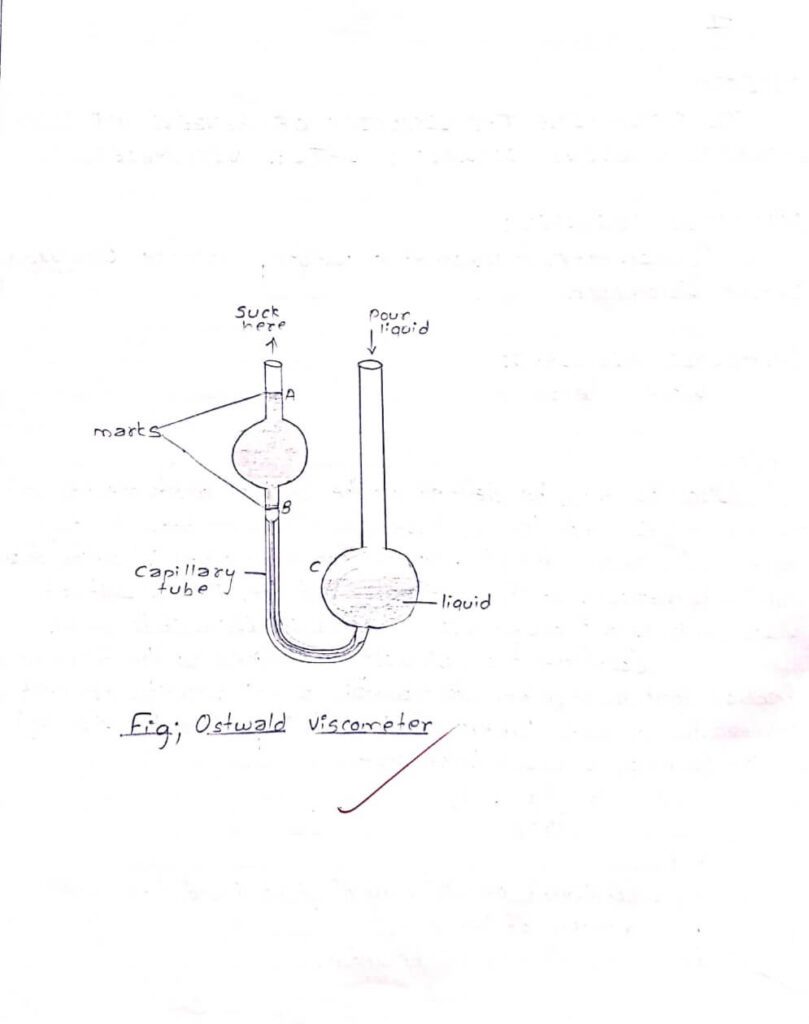APPARATUS REQUIRED:
Pycnometer, thermometer, weighing balance, Ostwald’s U-tube Viscometer.
CHEMICALS REQUIRED:
Water, benzene
THEORY:
Viscosity may be defined as the force of resistance per unit area which will maintain unit velocity difference between two layers of a liquid at unit distance from each other Viscosity of a liquid is measure of its frictional resistance. The SI unit of viscosity is N/m² or kg/ms whereas its CGs unit is poise.
Coefficient of viscosity is defined as the force of friction that is required to maintain a unit velocity gradient between two parallel layers of fluid. It is denoted by eta (η)
The formula is given below as:-
η1 =d1t1/d2t2 x η2
where,
η1 =coefficient of viscosity of given liquid (benzene)
d₁ = density of benzene
t₁ = time of flow of benzene
d2 = density of water
t2 = time of flow of water
η2 = Coefficient of viscosity of water,
PROCEDURE:
i) A clean and dry apparatus called Ostwald viscometer was taken whose left-hand limb was essentially a pipette with two marks A & B and length of capillary tube joined the pipette to a bulb C in the right-hand limb.
ii) A definite volume of water was poured into the bulb C with a pipette.
iii) The water was sucked up near to the top of the left-limb with the help of a rubber tubing attached to it.
iv) The water was then released to flow back into the bulb c.The time from A to B was noted with a stopwatch.
v) Same process was repeated up to 2-3 times to obtain concurrent reading.
vi) Then, the apparatus was washed, cleaned & dried and the experiment repeated with given liquid (benzene), taking about the same volume.
vii) The time of flow of benzene from A to B was recorded up to 2-3 times.
viii) Then, a clean & dry pycnometer was weighed & its value was noted.
ix) Then, the bottle was completely filled with water and weighed and its value was noted. Similar process was repeated for benzene to determine the density of benzene respectively with the help of a pycnometer.
x) Knowing the value of the viscosity coefficient of water at room temperature, the absolute Viscosity coefficient of benzene could be determined.

OBSERVATION:
Room temperature = 26°C
Weight of empty pycnometer (W₁) = 32.8 gm
weight of pycnometer and water (W2) = 83.53 gm
Weight of pycnometer and benzene (w3) = 77.08 gm
Density of water at given temperature (d2) = 1000kg/m³
Viscosity of water (η2) = 0.0091 poise
| Water | Liquid (benzene) | ||
| time of flow in second | Mean value | time of flow in second | mean value |
| ti = 32.01 sec | ti = 28.04 sec | ||
| tii = 32.05 sec | t2 = 31.75sec | tii = 28.67 sec | t1 = 28.20sec |
| tiii = 31.2 sec | tiii = 28.50 sec |
CALCULATION:
Density of of benzene (d1) = mass of benzene/mass of equivalence of water x density of water at 26°C
= W3-w1/w2-w1 x 1000
= 77.08 – 32.8/83.53 – 32.8 x 1000
= 44.28/50.73 x 1000
= 872.856 kg/m³
Therefore, The density of benzene (d1) is 872.856kg/m³.
Then,
Viscosity coefficient of benzene (η1) = d1t1 / d2t2 x n2
= 872.856×28.20/1000×31.75 x 0.0091
=0.775 x 0.0091
=0.00705 poise
RESULT:
Therefore, the viscosity of benzene at room temperature using the Ostwald viscometer is 0.00705 poise.
